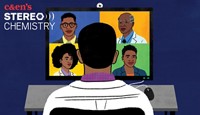Advertisement
Grab your lab coat. Let's get started
Welcome!
Welcome!
Create an account below to get 6 C&EN articles per month, receive newsletters and more - all free.
It seems this is your first time logging in online. Please enter the following information to continue.
As an ACS member you automatically get access to this site. All we need is few more details to create your reading experience.
Not you? Sign in with a different account.
Not you? Sign in with a different account.
ERROR 1
ERROR 1
ERROR 2
ERROR 2
ERROR 2
ERROR 2
ERROR 2
Password and Confirm password must match.
If you have an ACS member number, please enter it here so we can link this account to your membership. (optional)
ERROR 2
ACS values your privacy. By submitting your information, you are gaining access to C&EN and subscribing to our weekly newsletter. We use the information you provide to make your reading experience better, and we will never sell your data to third party members.
ACS News
ACS Meeting News: National Academies report calls for improved chemistry communication with the public
by Andrea Widener
March 17, 2016

When members of the public think of chemistry, they often conjure images of explosions and pollution rather than new materials, drugs, or energy solutions.
That’s the view being taken by a National Research Council report released earlier this month that aims to give chemists better tools for explaining chemistry to nonscientists. “We need to break down that barrier,” said Northwestern University chemistry professor Mark A. Ratner when announcing the report at a press conference this week at the American Chemical Society national meeting in San Diego. Ratner is cochair of the committee that created the report.
The report, “Effective Chemistry Communication in Informal Environments,” argues that chemists face special challenges when communicating with the public. Most people take just one high school chemistry class. And outside of school, chemistry is underrepresented in the public discourse about science. For example, chemistry is the field least likely to be shared online, the report shows, and it is underrepresented in science museums compared with other science disciplines.
“We spend 95% of our lives outside of school, so it is really important to get chemistry into that realm,” said Theresa Fryberger, director of the National Academies’ Board on Chemical Sciences & Technology, which teamed up with its science education board to propose this study.
The report—and a related guide for scientists—puts forward five recommended steps that chemists should go through when giving talks to nonscientists or creating outreach programs. “Chemists are enthusiastic, but we haven’t been trained to do this,” explained panel member Mary Kirchoff, education division director for ACS, which publishes C&EN.
NAS Report’s Framework for Effective Chemistry Communication
- Set communication goals and outcomes appropriate to the target participants
- Identify and familiarize yourself with your resources
- Design the communication activity and how it will be evaluated
- Communicate!
- Assess, reflect, and follow up
One recommendation is that chemists start outreach projects by taking time to learn about their audience, whether it’s an informal talk to a book club or a more organized event through a museum or afterschool program. “The emphasis is on the individual, the learner, the participant. Understanding what is relevant to them is critical,”
Among the committee’s most important recommendations is that chemists should ask that their outreach efforts be critiqued so that they can improve, whether it’s through a two-question survey or a show of hands. “It doesn’t need to be fancy,” Ucko explained.
The committee aims to help as many chemists as possible in the next year, Ratner said. “We hope these two guides will help the community who is interested in chemistry communicate much better.”
Related stories:



Join the conversation
Contact the reporter
Submit a Letter to the Editor for publication
Engage with us on Twitter